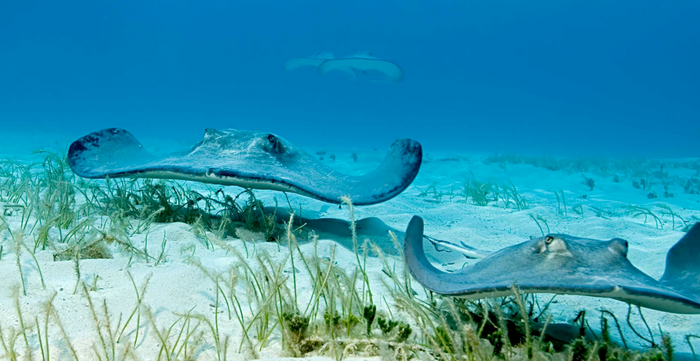Key points
- The Stingray Shuffle, a method of sliding feet along the sand, can help avoid stingray stings.
- Stingray stings are painful and venomous, often requiring immediate medical attention.
- Treatment for stingray stings includes hot water application, elevation, pressure, and cleaning the wound.
- Some people may have severe allergic reactions to stingray stings, including nausea, vomiting, and swelling.
- Some people may have severe allergic reactions to stingray stings, including nausea, vomiting, and swelling. Stingray stings can also easily become infected, making it important to seek medical attention for proper care and treatment.

Stingray Sting Protection
The Stingray Shuffle is a real and determined movement to help you avoid stings. The Tampa Bay Times offers that most people get stung because they dash for the water and enter using big steps. Large steps attract stingrays that live in shallow water. Stingrays bury themselves under a thin layer of sand and large steps entice stingrays to reveal themselves and sting.
The Stingray Shuffle is simply "sliding your feet along the sand instead of taking big steps." To a stingray, these sliding movements feel more like vibrations, which scares them away. As the Tampa Bay Times says, "The ideas is to push the sand forward and cause a disturbance that displaces the stingray without you stepping on it." Stingrays also travel in groups or schools and are most active between 11:00 a.m. and 3:00 p.m. so during these times the Stingray Shuffle is an absolute must-do.
Related: Florida Beach Hazards You Need to Watch Out For
Nasty Barb of a Stingray
The pain from a stingray sting is severe and feels like sharp, radiating pain. Almost all stings occur on the top of the foot. Their stings are full of venom. You can tell a stingray sting if there is a small V-shaped cut on your ankle or the top of your foot. The barb of a stingray is much larger than that of a jellyfish.
Painful Treatment for Stingray Stings
While it's best to notify the lifeguard on duty and seek out an urgent care location, if you are stung there are a few things you can do while awaiting treatment. First, elevate your foot and apply pressure directly on the area with a towel or cloth. Use peroxide, soap, and water to clean the area once bleeding has stopped. Retail clinics and the doctors who work in them say hot water that is almost boiling will help ease the pain of a stingray sting. Very hot water helps to neutralize the venom and must be applied to the stung area for at least 30 to 90 minutes. This is a tricky solution, especially for young children. If the water is too hot, the skin can be burned. This is why it's best to know where to find urgent care near you to ensure the proper care is received.
Related: Types of Bee Sting Reactions and How to Act Fast
Allergic Complications of Stingray Stings
Some people can have a severe allergic reaction to stingray bites. They may experience nausea, vomiting, or have noticeable redness and swelling around the affected area. In addition, because stingray lacerations are open, it's easy for them to become infected.
If you plan on heading into waters where stingrays have been known to sting, do an Internet search on "urgent care near me" and setup an emergency plan for action you can implement if stung. Doctors at urgent care clinics will prescribe antibiotics to stop infection. They will also be able to gauge the right temperature of water to soothe the pain as well as prescribe pain killers if needed.
Because the stingray barb can create severe pain, infection or an allergic reaction, the Stingray Shuffle is a great way to avoid an unexpected attack.
FAQs
What is the Stingray Shuffle?
The Stingray Shuffle is a technique of sliding your feet along the sand, which helps avoid stingray stings.
Why is it important to do the Stingray Shuffle?
It's important because it helps avoid painful and venomous stingray stings that often require immediate medical attention.
How should I treat a stingray sting?
You should apply hot water, elevate the wound, apply pressure, and clean it. Seek immediate medical attention.
Can stingray stings cause allergic reactions?
Yes, some people may experience severe allergic reactions to stingray stings, including nausea, vomiting, and swelling.
What should I do if I plan on going into waters with stingrays?
It's best to have an emergency plan in place, including knowing the location of the nearest urgent care clinic.
What home remedy can help ease the pain of a stingray sting?
Very hot water, almost boiling, can help ease the pain of a stingray sting. It helps to neutralize the venom and should be applied to the stung area for at least 30 to 90 minutes. However, caution should be taken to avoid burning the skin, especially in young children.
What complications can arise from a stingray sting?
Some people can have a severe allergic reaction to stingray stings, experiencing symptoms like nausea, vomiting, and noticeable redness and swelling around the affected area. Additionally, because stingray lacerations are open, they can easily become infected.
What should be done if planning to enter waters known for stingray stings?
If planning to enter waters where stingrays have been known to sting, it's advisable to search for "urgent care near me" and set up an emergency action plan. Doctors at urgent care clinics can prescribe antibiotics to stop infection and gauge the right temperature of water to soothe the pain. They can also prescribe pain killers if needed.

